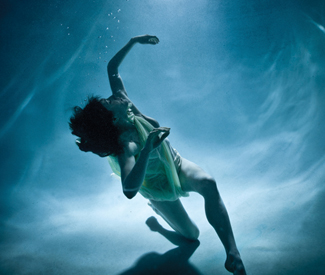DANCE Jodi Lomask has always been comfortable with both science and art. Perhaps that’s not surprising for someone who grew up with a physicist father and a visual artist mother — hanging around with his friends who would came to visit in Connecticut, and going with her to galleries and openings. Still, it’s not every child who, when trying to make sense of the world, was also “making dances” in her mind.
For the last 15 years, Lomask and her Capacitor collaborators (whose new work Okeanoswill be performed this weekend) have translated the dances in her head onto the stage. It’s a rather unusual way to establish an intimate human connection with the big world out there. Within Outer Spaces looked at our planet in context of the other heavenly bodies; Digging in the Dark examined Earth’s layers down to the molten core; futurespecies investigated reproduction in the past and the future.
For biome Lomask and her collaborators went to Costa Rica’s Monteverde Cloud Forest to study symbiotic relationships. For the upcoming premiere Okeanos, Lomask had herself certified as a diver and went to Bali to study marine protectorates and coral restoration projects.
Debunking the clichés of free-and-wild artists and right-brain-only scientists, she calls on the latter as essential collaborators and advisors.
“My personal theory is that art and science are at the bottom of a circle. As [their practitioners] get better, they separate for a while, but when they are very good they meet again,” she says. “The most successful scientists I know are also the most creative people I know. The most successful artists I know are the people who are very precise and rigorous in their craft; they have a lot of factual information that goes into their work.” It’s this kind of thinking that has made Lomask and Capacitor a regular participant at TED conferences.
In order to ground each work in “fact rather than fantasy,” in 2000 Lomask started a formal process consisting of six months of meetings between scientists and her creative team.
“A scientist makes a 20 minute presentation, then someone from our team — a designer, a musician — does the same,” she explains. “Then we have a show-and-tell about the specifics about what we are working on.” This way of working guides but also liberates the art-making because “we then can take off from factual information.”
At a late-stage rehearsal at Zaccho Dance Theatre’s whitewashed, concrete-walled studio, Okeanos‘ art and science elements were very much in evidence. Against the starkness of that environment, periodically punctuated by the rattling of a passing CalTrain, the stunning underwater videos by Australian cinematographer David Hannan suggested an unearthly yet innate beauty. Seahorses gave birth, an octopus explored its environment, schools of tiny fishes surrounded floating whales, and sharks shot by like torpedoes. Throughout, you got the sense that these creatures communicate with each other.
In addition to choreographing the movement vocabulary for the four dancers and five circus artists, Lomask also designed interactive physical structures that echo the natural world. One set calls up vortexes; another is an earth-like globe with many points of entry; yet another suggests a curtain of kelp. Lead science advisors Sylvia Earle and Tierney Thys provided taped narration. While helpful for its information, it’s most moving for the awe and love that is apparent in their voices.
As mentioned above, like many of Lomask’s works, Okeanos commingles circus artists and dancers. “It doesn’t make any difference to me whether a body is a trained dancer’s or a contortionist’s,” she says. “I am really interested in how the human body acts with the [sculptural] forms I have created. A contortionist can interact in a way a dancer cannot, but a dancer can embody an emotion or a concept that circus artists don’t have the training to do.”
Each Okeanos performance will be preceded by a different set of (separately ticketed) panel discussions surrounding issues of human interaction with the deep. The post-performance “Ocean Solutions Cafés” offer opportunities for continuing the conversation.
CAPACITOR: OKEANOS
Thu/12-Sun/15
Pre-show talks, 6:30pm, $20 (with show ticket); performances, 8pm, $25-$35
Herbst Pavilion
Fort Mason Center
Marina at Laguna, SF

